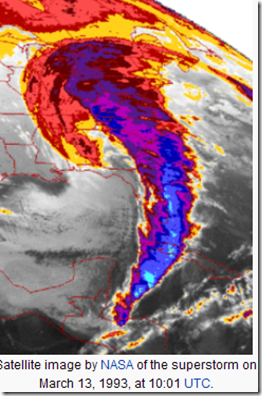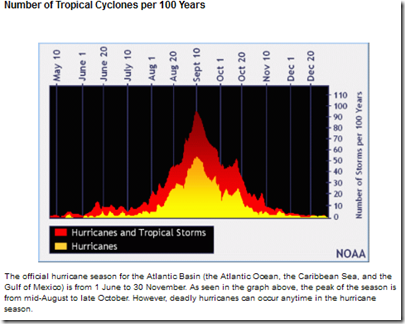
NHC – 5am Track
# 6654
Normally by the end of October most of us living in hurricane country begin to relax a bit, even though the the Atlantic tropical season runs through the end of November.
While admittedly late in the season - the National Hurricane Center in Miami is now tracking tropical storm Sandy – the 18th named storm in this active 2012 tropical season.
T.S. Sandy is headed slowly north – towards Jamaica – and may reach hurricane intensity before making landfall. The threat for now is to Jamaica and Haiti, and afterwards, probably eastern Cuba and the Bahamas.
Right now, Florida and the Eastern seaboard do not appear at risk, but residents should stay abreast of the latest advisories.
As you can see by the chart below, while rare, late season hurricanes are not unheard of. Tropical systems have formed in the Atlantic in every month of the year except January (note: There were 2 tropical systems that formed in December and hung around into January).
Credit NOAA
The areas of the Caribbean and Atlantic where tropical storms are apt to form, and move, change considerably late in the year.
Gone are the massive `Cape Verde’ storms which form in the eastern Atlantic in late summer, replaced by Caribbean systems spawned from the only waters still warm enough to spark a hurricane.
Credit NOAA
Curiously, the November historical `plot’ shown above almost exactly matches the projected path of T.S. Sandy; across Jamaica, Cuba, then out to sea.
Of course, the threat to the seaboard never really ends, for we now we are entering the season of the Nor'easter, massive winter storms that can often reach or exceed hurricane strength while producing blizzard conditions.
In recent memory, the Granddaddy of all Nor’Easter’s was the March storm of 1993. This destructive `Super storm’ brought a 10 foot surge tide out of the Gulf of Mexico that battered the west coast of Florida, pushed by hurricane force winds that lasted for 12 hours.

It then raked up the eastern seaboard dumping record amounts of snow from the Florida Panhandle to New England. Along the way it claimed more than 300 lives and inflicted more than $6 billion dollars in damage.
A not-so-gentle reminder that disasters can occur with little or no warning, and that severe storms can show up even when the calendar says they shouldn’t.
Preparedness is truly a year-round responsibility.
For more information on how to prepare for disasters or emergencies, the following sites should be of assistance.
FEMA http://www.fema.gov/index.shtm
READY.GOV http://www.ready.gov/
AMERICAN RED CROSS http://www.redcross.org/
A few of my preparedness blogs you might wish to revisit including:
In An Emergency, Who Has Your Back?


